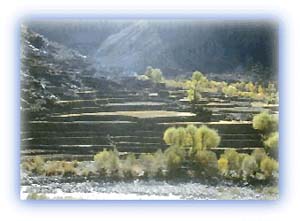Ladakh himalayas
General Info
· Valleys and plateaus
· Lakes
· Passes
· Glaciers
· Rivers
· People
· Religion
· Fairs and festivals
· Other places of interest

![]()
| Villages in Ladakh In such an inhospitable climate and desert land, a village must center around a stream. The streams here come from the glaciers of higher reaches and form parts of rivers most of which eventually flow into the Indus. Wherever a stream roams through a broadening valley, it is possible to lay a series of terraced fields, which can be irrigated in turn by directing the water supply into small artificial water courses. |
 |
| Cultivable land is rare in the region. Credit: Discover India |
In the bigger houses, one room is dedicated as a little private chapel, used mainly by the master of the house for reading his holy books and repeating his prayers. Where a whole room cannot be set apart, a small corner in the best room will be arranged as an altar.
All rights reserved